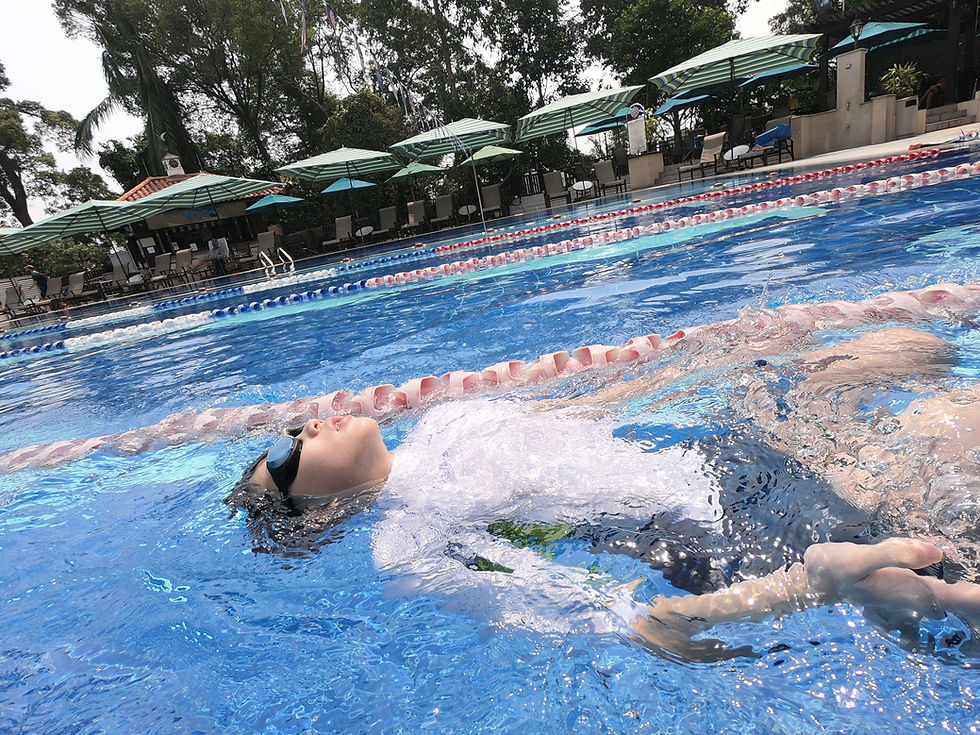How to Develop a Competitive Backstroke Strategy on Your Own
- SG Sink Or Swim

- Jun 20
- 3 min read

Backstroke is a dynamic and technically demanding stroke that rewards swimmers who combine strong fundamentals with intelligent race planning. Whether you're training solo or looking to fine-tune your competitive edge without a coach, learning how to develop your own backstroke strategy can give you a significant advantage in races.
In this guide, we’ll walk you through the key components of creating a self-directed, competitive backstroke strategy—from pacing and stroke count to start execution and turns.
🧠 Why Strategy Matters in Backstroke
Even with solid technique and fitness, a lack of strategy can lead to:
Inefficient pacing
Poor turn timing
Inconsistent stroke rhythm
Wasted energy during breakouts or finishes
A smart backstroke strategy helps you:
Maximize your strengths
Manage fatigue across distances
Shave seconds off your race time
🏁 1. Know Your Distances and Goals
Your strategy depends on whether you're racing:
50m: explosive power and start control
100m: speed endurance and breakout transitions
200m: pacing, efficiency, and stroke rhythm
🎯 Start by setting clear time goals for each event and identifying your strongest areas (e.g., starts, underwaters, mid-pool speed).
🧮 2. Establish Your Stroke Count and Tempo
Stroke count is key to pacing and efficiency. The fewer strokes per length (with proper technique), the more efficient your race.
How to track it:
Swim 25m at race pace and count strokes.
Do the same for 50m and 100m.
Track this weekly to see how it changes with fatigue or pacing.
✅ Use a tempo trainer to practice maintaining stroke rate while controlling effort.
🚀 3. Develop a Strong Start and Breakout Plan
The backstroke start sets the tone for your race.
Key elements to train:
Arch and push explosively off the block
Enter with minimal splash and into a tight streamline
Maximize your underwater dolphin kicks (legal up to 15 meters)
🔁 Practice backstroke start + breakout combos:
8×15m max effort start and streamline
Use cones or markers to measure your breakout distance
✅ Track how far you can hold your dolphin kicks before transitioning to full stroke.
🔄 4. Master Turn Timing and Execution
Turns in backstroke can gain or lose valuable time.
Self-coaching drills:
Count your strokes from flags to wall and memorize the number
Practice flip turns with and without stroke flags
Use underwater cameras or mirrors to check head position and rotation
✅ Make your turn automatic by consistently training your “stroke count to turn” number.
🏊♂️ 5. Customize Your Pacing Strategy
Each swimmer has a natural rhythm. Decide whether you’re best suited to:
Front-end loading: Going out fast, holding on
Even pacing: Controlled splits throughout
Negative split: Finish faster than you started
DIY pacing set:
✅ Choose the strategy that keeps your technique intact when fatigued.
💪 6. Include Stroke-Specific Conditioning
Backstroke relies heavily on:
Shoulder and back strength
Core control
Hip-driven flutter kick
Dryland ideas:
Pull-ups and lat pulldowns
Planks and leg lifts
Flutter kicks and resistance band pulls
✅ Build power and endurance to support race-level stroke demands.
📹 7. Film Yourself and Review Often
If you don’t have a coach, video is your best coach.
What to look for:
Are your hands entering in line with your shoulders?
Are your hips close to the surface?
Is your kick steady and symmetrical?
Is your head still and aligned?
✅ Review footage monthly and make one correction at a time.
🧠 8. Mental Strategy and Visualization
Racing is as much mental as physical. Practice visualizing:
Your perfect start and breakout
Smooth turns and strong push-offs
A confident final 15 meters to the finish
✅ Build mental resilience by visualizing your race plan before training and competition.
📝 Sample Weekly Self-Coached Backstroke Plan
Day | Focus | Sample Set |
Monday | Tempo + Stroke Count | 8×25 backstroke @ controlled tempo + stroke count |
Tuesday | Kick and Core | 6×50 kick with fins + dryland core set |
Thursday | Starts + Breakouts | 10×15m explosive backstroke starts |
Saturday | Endurance + Turns | 5×100 negative split + 6×12.5 flip turns |
🏁 Final Thoughts
Developing a competitive backstroke strategy on your own is fully achievable with intentional training, consistency, and self-analysis. Focus on building a strategy that suits your stroke rhythm, racing distance, and strengths — and track your progress with regular metrics and video review.
You don’t need a coach to think like a coach. With discipline and smart planning, you can elevate your backstroke to the next level — one length at a time.





Comments